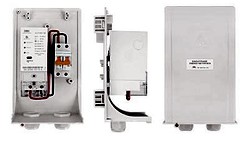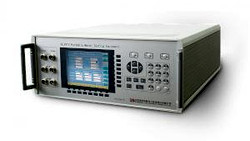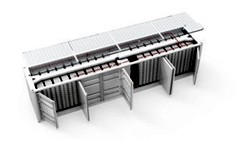The Baden-Württemberg network operator TransnetBW issues a newsletter called Transparent. The latest, issue 01/24, is quite something. Let me quote Mirjam König, Team Leader for System Behaviour (follow the link above to read the original German text). She led the winter analyses of the four transmission system operators in 2022, better known as the 'stress test'.
"Circumstances have been found in which a single n-1 error could lead to a system interruption. This means, for example, if lightning were to strike causing such a line to fail, then the power grid could become unbalanced. That is quite significant! The network would thus no longer be n-1 secure, even though n-1 security is a fundamental principle of German network planning. And this has also been noticed by politicians."
While such news can be rather concerning, let's examine the general principles of analysis:
As electric grids become more complex with larger shares of renewable energy, transmission system operators must carefully assess system reliability risks under foreseeable outage scenarios.
A key analytical tool used for this purpose is known as "N-1 contingency analysis," which evaluates how a power system would perform if any single component failed or was unexpectedly removed from service. This contingency modeling approach helps planners identify weak points, limiting elements and overloaded facilities ahead of time to guide necessary upgrades or operational safeguards.
With more unpredictable distributed energy resources on the system, N-1 analysis grows increasingly important for maintaining grid stability through transient disturbances and preventing cascading blackouts.

The "N-1" nomenclature refers to contingencies that involve the loss of a single element, such as a generator, transmission line, transformer or other facility. Planners simulate "what if" scenarios by removing each component in turn from their base system models and studies how flows, voltages, thermal ratings and other operational parameters are impacted. Any violations of planning criteria like security limits or stability margins are flagged for corrective action plans to reinforce those parts of the network and make them less vulnerable to potential single point failures.
Some common elements considered in N-1 contingency assessments include:
- Generation unit or plant trips/failures:
Loss of the largest single or multiple generator cascading outages. - Transmission line outages:
Tripping of individual overhead lines or underground cables due to faults. - Transformer failures:
Loss of an autotransformer, two-winding transformer or three-winding transformer bank. - Shunt capacitor/reactor outages:
Removal of static var devices for voltage support or damping. - Circuit breaker failures:
Opening of a transmission path due to a stuck breaker. - Common mode events:
Concurrent losses affecting shared structures like double-circuit towers. - Planned and maintenance outages:
Outage schedules for repairs, inspections, upgrades.
To be studied under N-1, contingencies must be specific, credible occurrences that planning engineers can reasonably expect may happen over the study timeframe. This could range from forced outages due to equipment failures to scheduled maintenance periods. The list of applicable contingencies varies between systems depending on asset characteristics, operating practices and environmental factors that influence component reliability.
N-1 analysis is typically performed for both pre-contingency steady-state power flows and dynamic post-contingency simulations of stability, voltage performance and thermal overloading.
Steady-state studies assess whether power flows can be safely redispatched to relieve overloads on remaining facilities following the contingency.
Dynamic simulations model transient swings in frequency and voltages as the system temporarily adjusts before settling into a new operating point. This tests issues like generator stability margins, voltage collapse points and special protection system actions.
Depending on the scope and complexity of a transmission provider's system, thousands or even tens of thousands of individual N-1 contingency assessments may need to be run as part of an annual planning process.
Automated contingency selection tools help planners efficiently identify the most critical outage scenarios to prioritize in detail based on screening criteria. Only a subset of the most impactful contingencies warrant intensive dynamic modeling, with others cleared through simpler steady-state analysis.
Results inform the selection of corrective upgrades designed to eliminate any identified system weaknesses and address planning standards compliance issues. Typical reinforcements include transmission lines, phase-shifting transformers, series compensation devices, synchronous condensers, breaker-and-a-half configurations and substation expansions.
In some cases, operational procedures like adjusted generator dispatch patterns or transmission loading relief schemes also alleviate N-1 reliability concerns.
Distributed energy resource characteristics enhance the importance of N-1 evaluation for future planning. While individual rooftop solar panels or neighborhood battery energy storage systems pose negligible risks to the bulk system alone, their aggregate impact as "contingencies" warrants scrutiny.
For example, modeling clusters of localized renewable generation or loads effectively removed from service addresses key uncertainties introduced by variable, weather-driven supply and demand-side resources integrated across distribution levels.
Advanced computing enables transmission owners to perform more probabilistic N-1 risk assessments using Monte Carlo simulations factoring fleet outage probabilities. Monte Carlo simulations are a mathematical technique used to understand the impact of risk and uncertainty in prediction and forecasting models. Named after the famous casino in Monaco, this method uses randomness and statistical sampling to solve problems that might be deterministic in principle.
Studies consider probability distributions and common cause effects of outages rather than only worst-case scenarios. Results provide deeper visibility into overall system adequacy, frequently seen outcomes and contingencies driving the largest losses of load or generation. This supplements traditional deterministic modeling to more comprehensively address reliability according to industry reliability standards.
Looking ahead, as the proportion of distributed energy rises and interregional coordination grows increasingly vital, multi-temporal and wide-area N-1 analysis spanning transmission providers will improve collective preparedness. Transparent data sharing already lets neighboring systems consider external impacts, and new transmission-distribution coordination platforms will enhance cross-sector contingency response. With robust N-1 planning practices continually adapted for evolving grid complexities, system operators strengthen defenses against potential single point-of-failures compromising reliability as energy transformations continue shaping power delivery worldwide.
Takeaway
The "N-1" contingency analysis is an indispensable tool in maintaining the integrity of power systems, particularly as we navigate the integration of renewable energy.
While the task grows more complex, the industry's commitment to innovation and collaboration ensures that grid operators are well-equipped to manage the challenges ahead. By embracing new technologies and methodologies, the power grid will not only remain resilient but will also support the sustainable energy transition that is vital for our future.
Thank you for reading. If you would like to share your thoughts or insights, please feel free to leave a comment below. We value your feedback and are always eager to hear from our readers.
Until then, keep shining bright like a solar panel on a sunny day!






All comments are moderated before being published. Inappropriate or off-topic comments may not be approved.